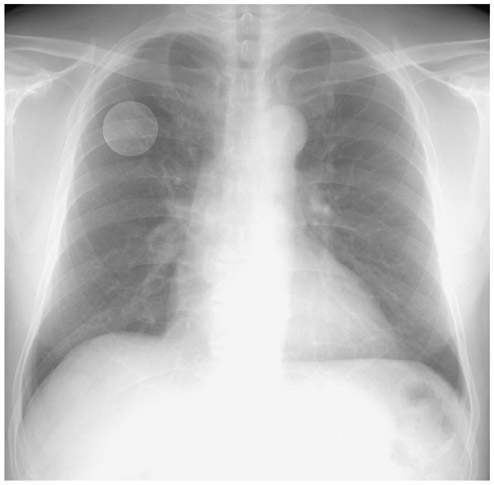Korean J Radiol.
2012 Oct;13(5):564-571. 10.3348/kjr.2012.13.5.564.
Computer-Aided Detection of Malignant Lung Nodules on Chest Radiographs: Effect on Observers' Performance
- Affiliations
-
- 1Department of Radiology, Seoul National University College of Medicine, Institute of Radiation Medicine, Seoul National University Medical Research Center, Seoul 110-744, Korea. jmgoo@plaza.snu.ac.kr
- 2Cancer Research Institute, Seoul National University, Seoul 110-799, Korea.
- KMID: 1392934
- DOI: http://doi.org/10.3348/kjr.2012.13.5.564
Abstract
OBJECTIVE
To evaluate the effect of computer-aided detection (CAD) system on observer performance in the detection of malignant lung nodules on chest radiograph.
MATERIALS AND METHODS
Two hundred chest radiographs (100 normal and 100 abnormal with malignant solitary lung nodules) were evaluated. With CT and histological confirmation serving as a reference, the mean nodule size was 15.4 mm (range, 7-20 mm). Five chest radiologists and five radiology residents independently interpreted both the original radiographs and CAD output images using the sequential testing method. The performances of the observers for the detection of malignant nodules with and without CAD were compared using the jackknife free-response receiver operating characteristic analysis.
RESULTS
Fifty-nine nodules were detected by the CAD system with a false positive rate of 1.9 nodules per case. The detection of malignant lung nodules significantly increased from 0.90 to 0.92 for a group of observers, excluding one first-year resident (p = 0.04). When lowering the confidence score was not allowed, the average figure of merit also increased from 0.90 to 0.91 (p = 0.04) for all observers after a CAD review. On average, the sensitivities with and without CAD were 87% and 84%, respectively; the false positive rates per case with and without CAD were 0.19 and 0.17, respectively. The number of additional malignancies detected following true positive CAD marks ranged from zero to seven for the various observers.
CONCLUSION
The CAD system may help improve observer performance in detecting malignant lung nodules on chest radiographs and contribute to a decrease in missed lung cancer.
MeSH Terms
Figure
Reference
-
1. Muhm JR, Miller WE, Fontana RS, Sanderson DR, Uhlenhopp MA. Lung cancer detected during a screening program using four-month chest radiographs. Radiology. 1983. 148:609–615.2. Austin JH, Romney BM, Goldsmith LS. Missed bronchogenic carcinoma: radiographic findings in 27 patients with a potentially resectable lesion evident in retrospect. Radiology. 1992. 182:115–122.3. Monnier-Cholley L, Arrivé L, Porcel A, Shehata K, Dahan H, Urban T, et al. Characteristics of missed lung cancer on chest radiographs: a French experience. Eur Radiol. 2001. 11:597–605.4. Quekel LG, Kessels AG, Goei R, van Engelshoven JM. Miss rate of lung cancer on the chest radiograph in clinical practice. Chest. 1999. 115:720–724.5. Choi EJ, Jin GY, Han YM, Lee YS, Kweon KS. Solitary pulmonary nodule on helical dynamic CT scans: analysis of the enhancement patterns using a computer-aided diagnosis (CAD) system. Korean J Radiol. 2008. 9:401–408.6. Song KD, Chung MJ, Kim HC, Jeong SY, Lee KS. Usefulness of the CAD system for detecting pulmonary nodule in real clinical practice. Korean J Radiol. 2011. 12:163–168.7. Goo JM. A computer-aided diagnosis for evaluating lung nodules on chest CT: the current status and perspective. Korean J Radiol. 2011. 12:145–155.8. Kakeda S, Moriya J, Sato H, Aoki T, Watanabe H, Nakata H, et al. Improved detection of lung nodules on chest radiographs using a commercial computer-aided diagnosis system. AJR Am J Roentgenol. 2004. 182:505–510.9. Shiraishi J, Li F, Doi K. Computer-aided diagnosis for improved detection of lung nodules by use of posterior-anterior and lateral chest radiographs. Acad Radiol. 2007. 14:28–37.10. Bley TA, Baumann T, Saueressig U, Pache G, Treier M, Schaefer O, et al. Comparison of radiologist and CAD performance in the detection of CT-confirmed subtle pulmonary nodules on digital chest radiographs. Invest Radiol. 2008. 43:343–348.11. He Q, He W, Wang K, Ma D. Effect of multiscale processing in digital chest radiography on automated detection of lung nodule with a computer assistance system. J Digit Imaging. 2008. 21:Suppl 1. S164–S170.12. Kasai S, Li F, Shiraishi J, Doi K. Usefulness of computer-aided diagnosis schemes for vertebral fractures and lung nodules on chest radiographs. AJR Am J Roentgenol. 2008. 191:260–265.13. Li F, Engelmann R, Metz CE, Doi K, MacMahon H. Lung cancers missed on chest radiographs: results obtained with a commercial computer-aided detection program. Radiology. 2008. 246:273–280.14. van Beek EJ, Mullan B, Thompson B. Evaluation of a real-time interactive pulmonary nodule analysis system on chest digital radiographic images: a prospective study. Acad Radiol. 2008. 15:571–575.15. White CS, Flukinger T, Jeudy J, Chen JJ. Use of a computer-aided detection system to detect missed lung cancer at chest radiography. Radiology. 2009. 252:273–281.16. de Hoop B, De Boo DW, Gietema HA, van Hoorn F, Mearadji B, Schijf L, et al. Computer-aided detection of lung cancer on chest radiographs: effect on observer performance. Radiology. 2010. 257:532–540.17. Chakraborty DP. Analysis of location specific observer performance data: validated extensions of the jackknife free-response (JAFROC) method. Acad Radiol. 2006. 13:1187–1193.18. Giger ML, Chan HP, Boone J. Anniversary paper: History and status of CAD and quantitative image analysis: the role of Medical Physics and AAPM. Med Phys. 2008. 35:5799–5820.19. Li Q, Li F, Shiraishi J, Katsuragawa S, Sone S, Doi K. Investigation of new psychophysical measures for evaluation of similar images on thoracic computed tomography for distinction between benign and malignant nodules. Med Phys. 2003. 30:2584–2593.
- Full Text Links
- Actions
-
Cited
- CITED
-
- Close
- Share
- Similar articles
-
- Lung Nodule Detection on Chest CT: Evaluation of a Computer-Aided Detection (CAD) System
- A Computer-Aided Diagnosis for Evaluating Lung Nodules on Chest CT: the Current Status and Perspective
- Computer-Aided Detection of Lung Nodules on Chest CT: Issues to be Solved before Clinical Use
- Studies and Real-World Experience Regarding the Clinical Application of Artificial Intelligence Software for Lung Nodule Detection
- Fate of pulmonary nodules detected by computer-aided diagnosis and physician review on the computed tomography simulation images for hepatocellular carcinoma




